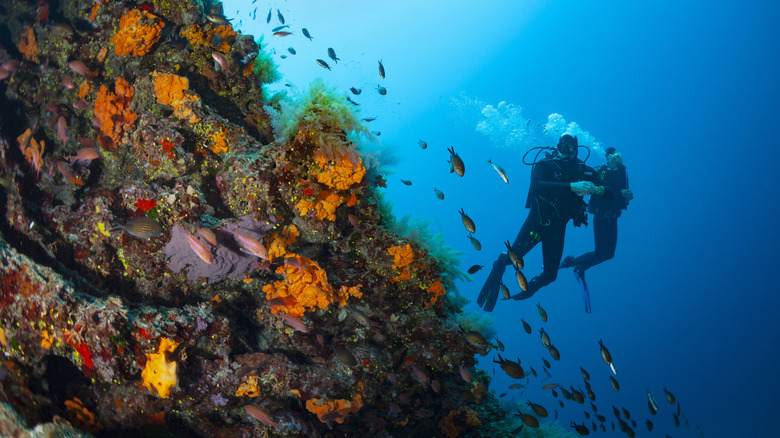
Southeast Asia is a diver's playground, and explorers of all levels can come out to play. Whether you're a beginner just dipping your fins into scuba, or are a seasoned diver who lives for strong currents (and the big underwater wonders they carry), or prefer mucking around for smaller stuff like nudibranchs and frogfish -- there's something in this part of the world for every kind of diver.
But this isn't your typical roundup of go-to diving destinations, though it does include some backpacker staples
like Ko Tao and Gili Trawangan. This list of island diving goes beyond the mainstream to also highlight under-the-radar gems in countries like Timor-Leste and Malaysia that are increasingly gaining credo in the global dive community. Many of these islands don't find mention in holiday brochures and may be devoid of travel indulgences like fancy bars or hotels, but the passionate diver will find them nothing short of heavenly.
Some picks came from data and expert input, while others were based on first-hand experiences from divers -- including myself, an Advanced Open Water-certified diver with a growing logbook that is closing in on 70 dives, the majority of which have been in these Southeast Asian countries. I haven't had the privilege of visiting some of these destinations yet, but you can best believe that they are sitting obsessively high on my bucket list. Here are 14 island dive spots in Southeast Asia that can't be missed.
Read more: 12 Destinations And Attractions That Should Absolutely Be Considered Wonders Of The World
1. Malapascua, Philippines
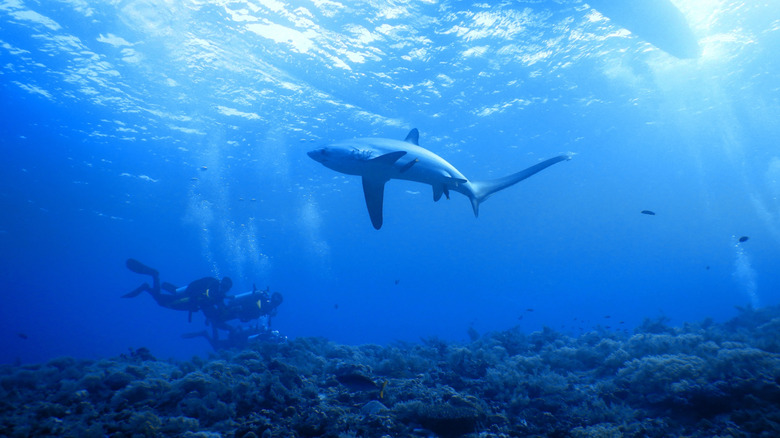
With over 7,000 islands and rich marine biodiversity, the Philippines is a well-known diver's paradise. Among its many underwater gems, the tiny island of Malapascua claims major bragging rights as one of the only dive spots in the world where the highly elusive, deep sea-dwelling thresher sharks consistently cross paths with divers almost daily. The action takes place in the early morning hours at Monad Shoal and Kimud Shoal, both of which house cleaning stations where these shy pelagics rise from the depths to be met and cleaned by smaller fish.
Hammerhead and tiger sharks can also be spotted around these parts. Since these dive sites drop deep and can be challenging, an Advanced Open Water certification is generally recommended before you take the plunge. But Malapascua can also be just as exciting for people only getting started in scuba. Gato Island is a divers' favorite, with sea snakes, pipefish, seahorses, and colorful nudibranchs populating the ecosystem here. Chocolate Island and Bugtong Bato are also must-visit bucket list spots.
2. Bali, Indonesia

Bali holds a high reputation as a haven for every kind of diver, all the way from enthusiastic newbies to experienced professionals and underwater photographers. Its location within the astoundingly biodiverse Coral Triangle has blessed it with underwater life like nowhere else on the planet, and divers are always guaranteed a wild, wonderful experience. My diving adventures took me first along the northeastern coast of the island, which is also a great stretch to explore if you want to escape the more crowded areas in Bali.
I set up base in Amed, one in a string of secret coastal fishing villages in this part of Bali. With a minimum of three dives a day nearly every day, I fell in love with Amed pretty quickly. Nudibranchs, turtles, ribbon eels, and scorpionfish were regular sightings. Tulamben, with its famous USAT Liberty shipwreck, was also a stone's throw away, and I managed to check that off my bucket list too. It was iconic, to put it mildly. One of my final stops was down south in Padangbai, a largely overlooked dive destination given its primary reputation as a stopover for island hoppers. It served me well, with its variety of specialties from cave dives to muck dives.
3. Tioman Island, Malaysia
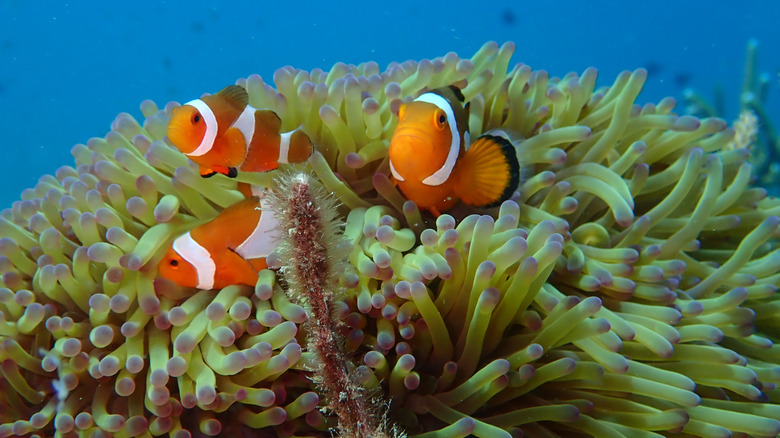
Something about Tioman Island took my breath away the moment I stepped off the ferry. Maybe it was the legacy of Time magazine famously calling it one of the world's most beautiful islands in the 1970s. Or maybe because it was just that stunning. Either way, I had an inkling that diving in this small, laid-back Malaysian paradise was going to be a blast. And I'm happy to report that it was. I began with dives at Chebeh and Kador Bay, two of the island's most rewarding sites in the northwest, greeted by a vibrant melange of coral and marine life almost immediately after descending.
The easy winner for me was Renggis, an island neighboring Tioman, where I was treated to sightings of an inflated pufferfish (clearly on high alert), an apparently very hungry turtle demolishing a chunk of coral, and a pair of sizeable but shy blacktip sharks that didn't hang around too long. Tioman also holds a special place in my heart (and dive logbook) as the location of my first ever night dive. It was magical, not simply for the surreal variety of nocturnal creatures I encountered -- think iridescent squid, eels, stingrays, and catsharks -- but also for the whole new world of scuba it opened up for me.
4. Koh Phi Phi, Thailand
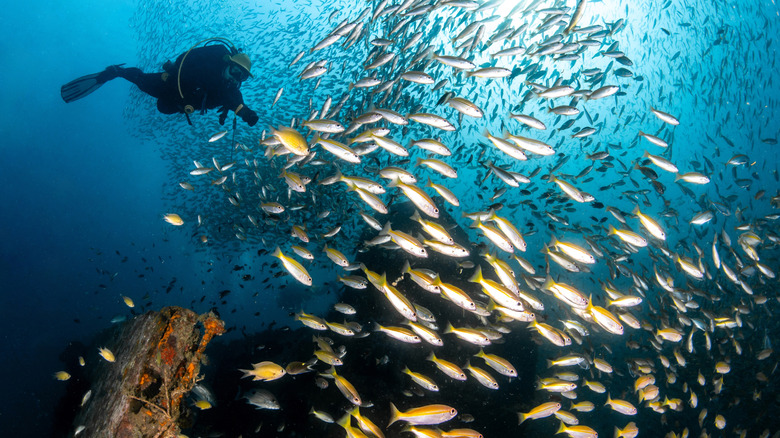
I was in Koh Phi Phi this year to ring in my birthday with a bunch of friends. But on the eve of the big day, I ditched the party island's notoriously potent cocktail buckets and went to bed at a fairly decent hour so I could be up nice and early for a special celebration 18 meters deep in the big, beautiful blue. My first birthday dive was at Koh Bida Nok, one of the most popular sites around the island, where resident reef sharks and huge schools of fish come out to greet divers. And they did, in all their glory.
Viking Cave, the next dive site, was equally thrilling but for different reasons. After the 2004 tsunami devastated areas around Phi Phi, conservation authorities installed an artificial reef structure on the shallow floor at Viking Cave, which is today home to a vibrant multitude of corals, fish species, and marine life. Visibility around these waters is superb, as is the warm temperature -- both of which make for comfortable, relaxed diving. Owing to limited time, I could not explore other popular spots like Palong Wall, Kled Gaeow, and Hin Bida on that dive trip, but they sure make for compelling reasons for me to return to Phi Phi.
5. Cebu, Philippines
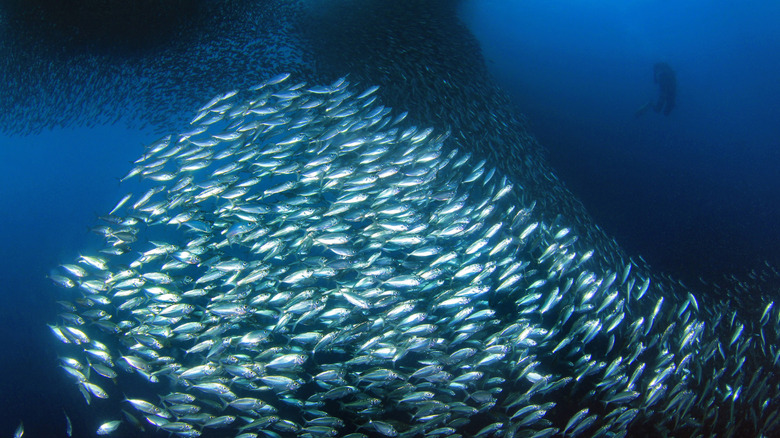
Few diving spots in the Philippines pack as much punch as Cebu. And as any well-traveled diver will confirm, Moalboal is one of the standout gems. The site off Panagsama Beach is one of Moalboal's most famous for its year-round sardine run, a stunning silver swirl of a million or more sardines that makes for a jaw-dropping underwater spectacle. (Friendly reminder to not let your jaw drop too far if you are scuba diving; your regulator's still in there.) If you're as lucky as this Reddit user, you may even encounter a thresher or whale shark here.
The diving scene in nearby Pescador Island is just as mesmerizing, with deep vertical walls, colorful corals, and a variety of marine life, including barracuda. Cathedral is an unmissable dive site here, offering cave swim-throughs against fantastic visibility. Further along the coast, Tongo Point is another sought-after site for divers looking for a relaxed, wonder-filled day out in the deep blue. Meanwhile, those seeking adrenaline-pumped diving can hit Sunken Island and Liloan Drifts for some exciting currents and wrecks.
6. Raja Ampat, Indonesia
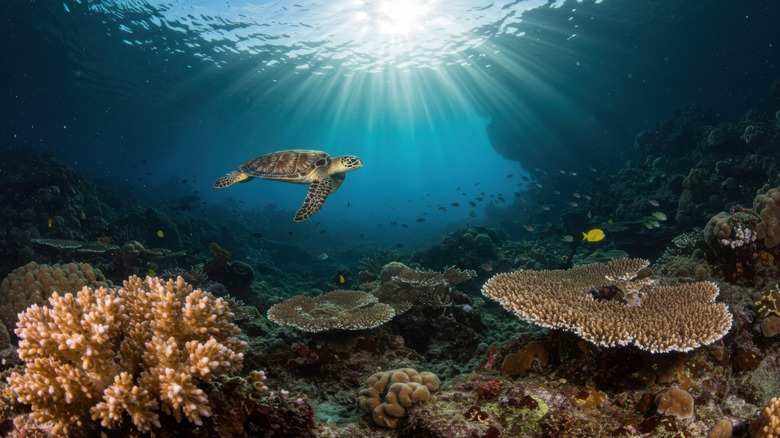
Raja Ampat, in more ways than one, is the heart and soul of the famed Coral Triangle. Known as the most biodiverse marine ecosystem anywhere on the planet, the nutrient-rich waters of Raja Ampat are famously home to over 1,500 fish species as well as about 75 percent of the world's coral species. So whether you're scouting for tiny pygmy seahorses, wanting to glide with mantas, or hoping to spot the uncommon walking sharks, every dive here is nothing short of an underwater dream. Casual divers may want to get some solid experience in before heading to Raja Ampat, since must-visit sites like Cape Kri and Blue Magic are prone to strong currents.
Considering the exclusivity of the diving experience here, getting to Raja Ampat isn't exactly simple. Located off the tip of West Papua in Indonesia, this island cluster demands a hop between international and domestic flights before ferry and speedboat transfers drop you to your final location. This very remoteness is what plays a hand in keeping Raja Ampat's marine life healthy and thriving. It is highly recommended, however, to inquire about prices and decide budgets before making the long journey to Raja Ampat, since neither diving nor liveaboards nor other stay options come cheap here.
7. Sipadan Island, Malaysia

Sipadan isn't rated as one of the world's best diving destinations for nothing. Lying just off the coast of Borneo, this Malaysian island offers some of the most spectacular dive sites accessed by humans, with the renowned Barracuda Point appearing on top 10 lists for years. Much as the name suggests, it's a spot for swirling vortexes of barracuda that create dramatic tornado-like shapes amidst strong currents. Add to that reef sharks, parrotfish, and morays, and you have yourself a scene from a nature documentary unfolding before your eyes. South Point is another equally popular and rewarding dive site.
Sipadan is a premium diving destination where conservation efforts are substantial and so, access is controlled here. For starters, just about 200 permits are issued to divers everyday so proper planning and bookings made well in advance are essential. Secondly, challenging underwater conditions are near-synonymous with Sipadan, which calls for ample logged dives, good buoyancy control, and a minimum of an Advanced Open Water certification as recommended by PADI before you dive in Sipadan. These requirements may sound stringent, but they're part of why Sipadan is held to such high standards.
8. Nusa Penida, Indonesia
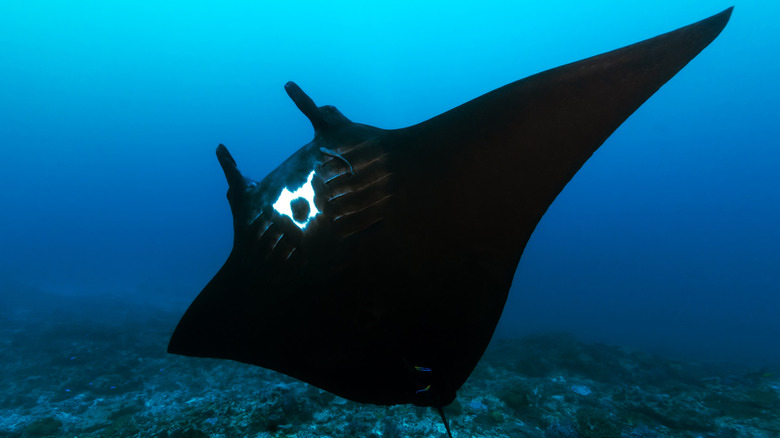
Everywhere I traveled to in Southeast Asia, divers wouldn't stop raving about this one dive site in Nusa Penida called Manta Point. So when I eventually touched down in Indonesia, I was keen on seeing for myself what all the hype was about -- and it did not disappoint. My dive boat went out from Padangbai, a town whose only standout reputation is as a ferry port to other islands but where accommodations and other travel essentials come cheap. (Padangbai is also surrounded by some absolutely brilliant but overlooked dive sites that you can have all to yourself!)
Even with the heavy commercialization and boat-infested waters of Manta Point, the dive site was absolutely surreal, with giant mantas gliding close to divers every so often. All you have to do is hang around and wait. Crystal Bay was another adventure with its burst of colorful corals and abundant fish life, and while it's a popular site for spotting mola molas, I unfortunately could not catch a glimpse; their season runs from July to November, and I was just a month early to the party. My third descent in Penida was at Ped, a favorite among drift divers and turtles alike. Needless to say, I enjoyed it to the fullest.
9. Atauro Island, Timor-Leste
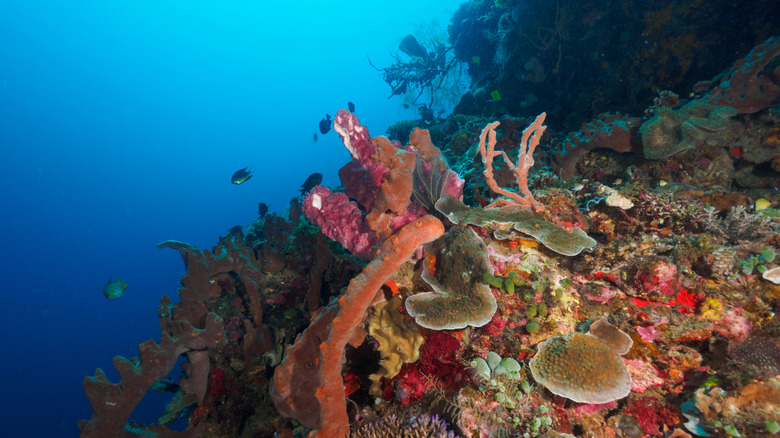
Timor-Leste is not a destination frequently heard in mainstream diving circles... yet. Situated east of Indonesia, this humble country doesn't attract the heavy tourism that its renowned neighbor does but is steadily emerging as a hidden gem for world-class diving. Its location within the Coral Triangle means the underwater life here is extremely rich, with a lot of fantastic diving clustered around Atauro Island. In fact, a study by Conservation International made global headlines in 2016 for the discovery that Atauro's waters boast the highest number of reef fish species per site on earth (via The Guardian).
So it's hardly surprising that divers who do manage to make the journey to Timor-Leste are rewarded with breathtaking underwater experiences. As one Reddit user mentioned in their dive report from Timor-Leste, "[F]or the more adventurous of you looking for sublime and untouched reefs, Timor is definitely up there." Diving is great off both coasts of Atauro, with sites like Adara Wall and Kitali in the west and Beloi Reef and Vila in the east. From macro life to coral-covered walls, pelagic sightings, and gentle drifts, a variety of diving wonders await in Timor-Leste.
10. Gili Islands, Indonesia
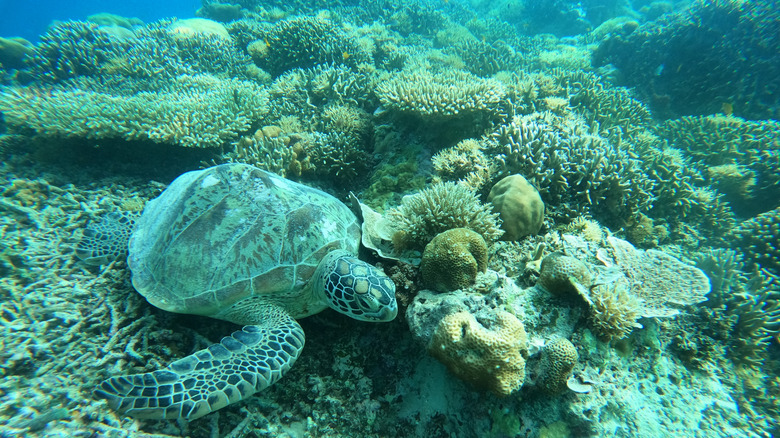
Famous as some of Indonesia's most breathtaking, pocket-friendly islands, the Gili Islands off the north coast of Lombok frequently make the bucket lists of eager partygoers, holidayers, and divers. I touched down in Gili Trawangan -- the most notorious of the Gili triad that also includes Gili Air and Gili Meno -- as part of the last camp. A little side note: It was an emotional full-circle homecoming of sorts. It was here that it had all begun for me just a few years prior, when I first ventured out into the big blue as a curious try diver. I was returning with an advanced certification and renewed passion to explore more of the Gili seas.
Bounty Wreck, Shark Point, Halik Reef, Hans Reef -- each dive site here is more breathtaking than the last. It would take pages to fill out the kinds of marine life one can expect to find, but a quick rundown would include turtles, reef sharks, stingrays, frogfish, moray eels, and clownfish. The visibility at most dive sites on most days is crystal clear; also consistent is the current, which can sometimes get strong but is nothing an experienced diver can't handle or enjoy. Since boats from all three islands visit the same dive sites, you can set up base at any one of them. Between Gili Trawangan's wild parties and Gili Meno's peaceful quietude, Gili Air is the perfect, balanced choice.
11. Ko Tao, Thailand
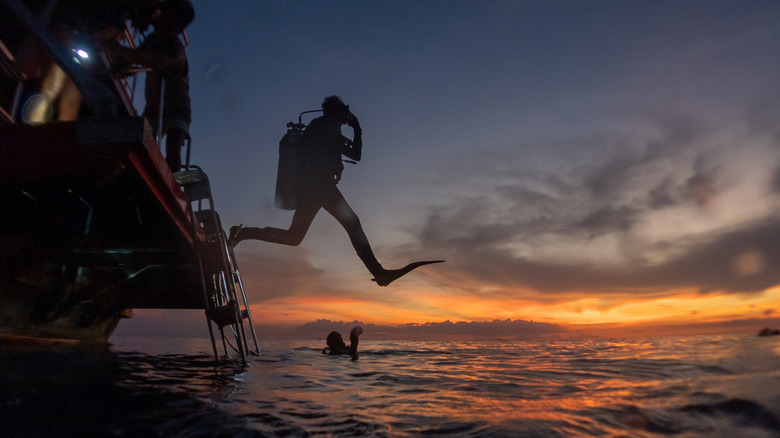
Rated highly among Thailand's best vacation islands, Ko Tao is a true gem for people keen on taking the plunge into scuba diving without breaking the bank. A globally renowned hotspot for getting scuba certified, the island teems with both novice and pro divers almost all year, given its long diving season that stretches between March and September. Batfish, stingrays, groupers, parrotfish, coral gardens -- you can expect to see all this and more in the waters of Ko Tao. (And if you're lucky, even whale sharks.)
Ko Tao's calm waters and easy conditions make it a great entry point into the sport for beginners, who will be spoilt for choice with dozens of dive shops offering to get you scuba-certified at very affordable rates. While the scale of commercialization here draws divided opinions in the scuba community, there is no denying the universal underwater appeal Ko Tao holds. Some dive sites like Chumphon Pinnacle, where currents are strong and depths go down to 45 meters, may be enjoyable only to experienced divers, but there are plenty of shallower sites Open Water divers can safely explore.
12. Apo Island, Philippines
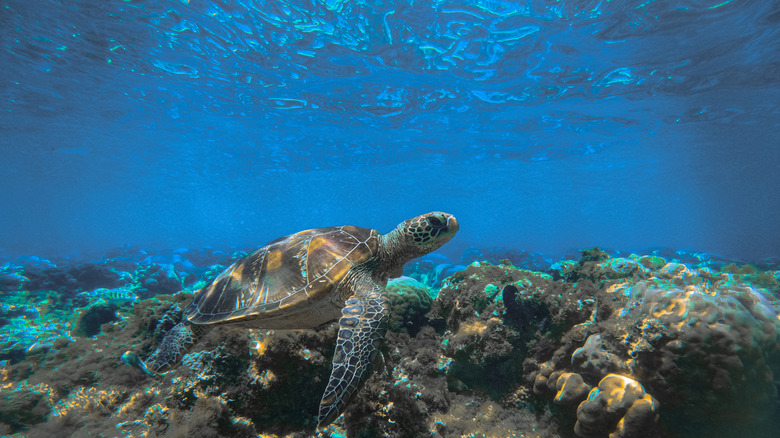
Decades ago, destructive fishing practices had nearly wrecked the reefs in Apo Island, Philippines. In a bid to revive the underwater ecosystem, the local community and marine scientists teamed up to create one of the country's first marine sanctuaries, and today, the island's abundant marine life -- with coral and fish species running in several hundreds -- attracts divers from all around the world. Travelers universally recommend this as one of the best places to swim with turtles.
Apo Island offers plenty of dive sites for all levels of divers; Chapel and Katipanan, for instance, are great for beginners keen on practicing their diving skills while enjoying the visual wonders of the sea. Coconut Point, meanwhile, enjoys a notoriously thrilling reputation as a washing machine, where currents are unpredictable and can rip through in any direction. It's a stunning drift, but getting some experience, dive logs, and certifications is highly recommended before you attempt it. From nearby Dumaguete, one can also access a plethora of brilliant macro diving spots.
13. Komodo, Indonesia
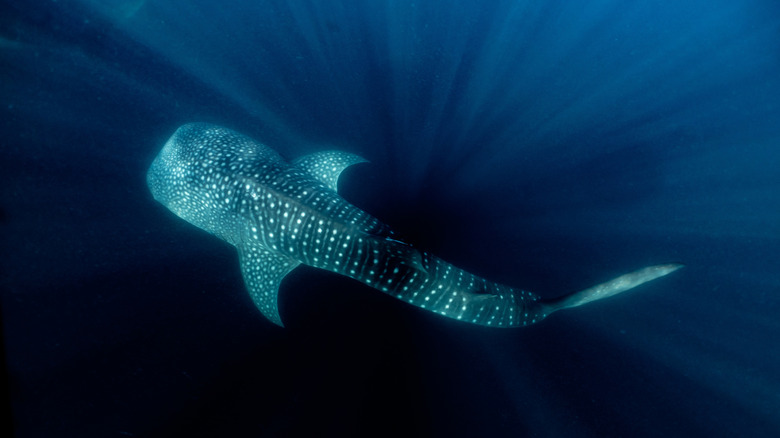
Diving in Komodo is not for the faint of heart, but for those willing to take the plunge in its famously current-swept waters, it is guaranteed to be absolute magic. Widely considered one of Indonesia's best diving destinations within the scuba community, Komodo boasts a treasure trove of thrilling drift dives, dramatic topography, and pelagic species that will ensure you get the best bang for your buck on every single dive. And as more than a few pros have told me, to make the most of diving in Komodo, liveaboards are the way to go.
Batu Bolong or Current City, Castle Rock, and Shotgun are some of the best and most notorious sites Komodo has to offer. While its reputation may intimidate newbies, the strong currents and unpredictable conditions here are exactly what make Komodo a great place to get started on your journey to becoming a confident, skilled diver. These waters are home to some extraordinary marine life -- schooling trevallies, manta rays, barracudas, and even whale sharks -- that come out to play when the currents do.
Methodology
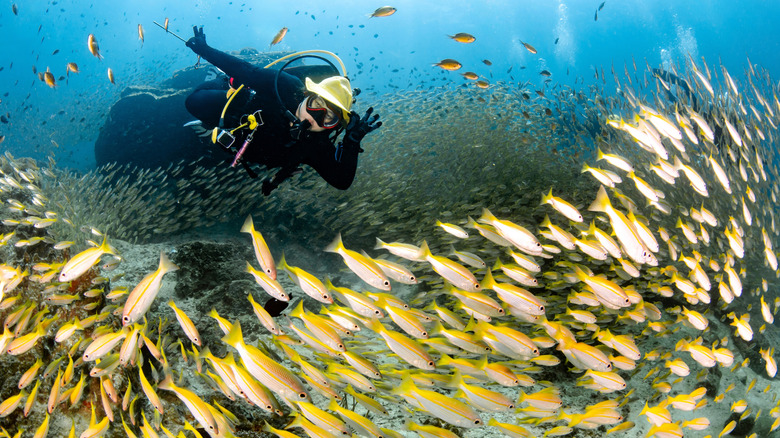
To put together this guide to some of the best island diving destinations across Southeast Asia, we leaned on a mix of personal experience, trusted community wisdom, and expert-backed resources. Whether you're only just getting into scuba or are an experienced diver, this list seeks to offer something for every recreational level. Many of the spots on this list are places I have dived at myself or sites that have long enjoyed strong reputations in the scuba world -- coming up frequently in dive shop conversations, training sessions, diver logs, and traveler wishlists.
To that end, this compilation is grounded in more than just anecdotal experience. It has been shaped by the collective voice of the global dive community, as evident in guidelines by certified dive shops, diver reviews, discussions on scuba forums, blogs, and resources from top organizations like PADI and SSI. We also factored in the richness of marine biodiversity, ease of accessibility, presence of reputable dive shops, specialty diving, and overall underwater conditions when selecting each destination so readers can choose according to their preferences.
Ready to discover more hidden gems and expert travel tips? Subscribe to our free newsletter for access to the world's best-kept travel secrets.
Read the original article on Islands.













